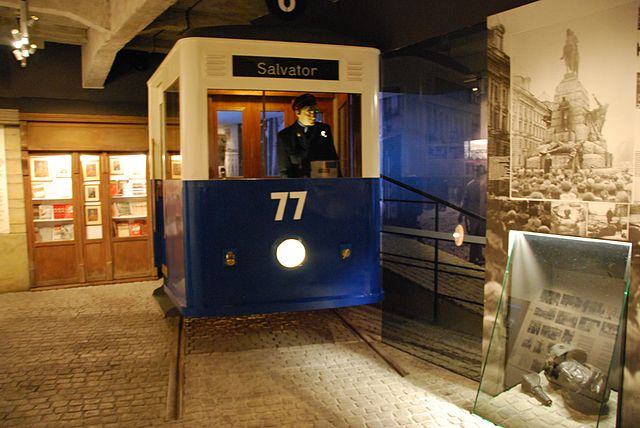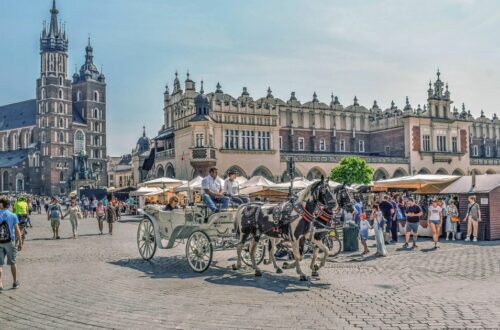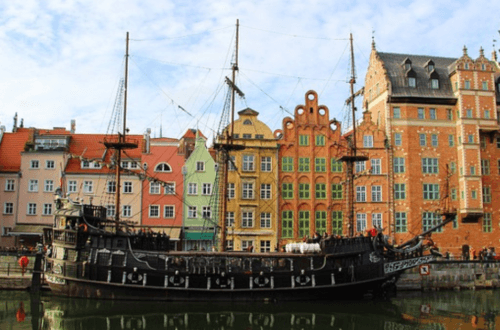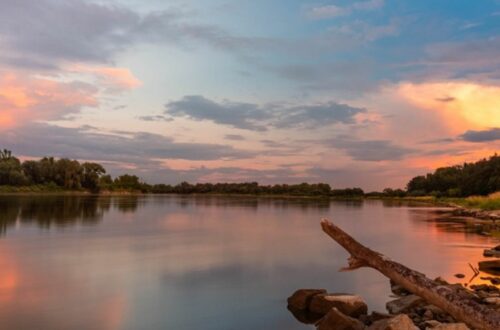Quirky and Cool; 12 Unusual Places to Visit in Poland
Poland is home to some of the most beautiful regions and wonders of nature which attract tourists from all over the world. We have some quirky places which may make you wonder who came up with the idea to create them, although some are simply a work of nature.
We’ve rounded up 12 of the weirdest and most wonderful places you can visit. Read on to discover some of the most mysterious and fascinating places in Poland.
1. Pyramid Rapa

You don’t have to go to Egypt to see a pyramid. Impressed yet? Maybe you won’t see the Tutankhamen’s tomb here, though you should catch sight of a unique crypt of the Prussian family of barons von Fahrenheid. This bizarre tourist attraction can be seen in Masuria’s northern part in the town of Rapa near the border with Russia.
I’m sure you are curious about Fahrenheit’s extraordinary crypt and asking yourself why baron decided to build a family tomb in the form of a pyramid? The answer is quite simple: the shape of the tomb is related to Baron Fredrich’s fascination with ancient Egypt. He believed that pyramids had extraordinary properties affecting the dead bodies. There are legends circulating in our country about this pyramid.
The most thrilling one is that Friedrich von Fahrenheid found his family dead at home upon returning from one of his journeys. It is said that the baron’s wife wanted to reconcile her two cousins before her husband returned. They have accidentally poisoned themselves with mushrooms at a gala dinner.
If you’re wanting to see one of Poland’s best attractions, Pyramid Rapa may just be the kind of thing you’ve been looking for.
2. Lapalice Castle

Yep, Poland actually does have a ghost castle. Well, at least one that looks like it. The castle in Łapalice could have been a building of extraordinary beauty. Due to legal “shortcomings” and money, the castle’s construction was suspended 26 years ago and has not been resumed since.
Let’s take a closer look at this building; well over 5,000 square meters, several floors, 52 rooms, 365 windows, a vast ballroom, swimming pool, and 12 turrets referring to the 12 apostles. People say that the founder lost his common sense and his imagination failed him.
Moving freely between the rooms, you won’t believe that the castle in Łapalice was built as a residential house. As in the case of Krzyżtopór Castle in Ujazd, you will notice a fascination with symbolism. Even though the castle has not been finished, it is paradoxically becoming prevalent amongst tourists.
If you’re a castle lover or just keen to visit interesting attractions, the Lapalice castle is an excellent choice to put on your list of things to see in Poland.
3. Skull Chapel Czermna

Did you know that Poland has a chapel made out of thousands of skeletons? I won’t blame you if you are surprised. This Massive grave is a unique work of religious culture, and it is famous throughout the country. Within the chapel, you’ll be able to watch the entire interior lined with human remains – real skulls and bones. Additionally, you will find 21,000 skeletons stored in the crypt under the chapel.
Local Priest Vaclav Tomasek gathered thousands of skulls and bones from numerous mass graves left by the Thirty Year’s war from (1618 – 1648) and from a cholera outbreak (1740 – 1763.)
If you want to experience something unusual, then you should definitely come here.
4. Project Riese & Ksiaz Castle
What are they hiding? The area became a hot spot for both local and international visitors when two explorers declared they had discovered a secret tunnel that housed the legendary wartime train loaded with loads of treasures.
Project Riese was the codename for an exciting construction project of Nazi Germany in 1943- 1945, consisting of seven underground structures located in the Owl Mountains and Książ Castle. Surely, the underworld of Książ Castle is one of the most mysterious places in Poland.
Take your family for a day trip to Project Riese & Ksiaz Castle and discover an eerie world of underground tunnels full of secrets.
5. The Ax Museum
Believe it or not, Poland has an ax museum. The ax Museum in Orzechowka, Holycross, houses a collection of over 2500 axes as its name suggests. It was founded in 2006 by a passionate Mr. Adolf Kudliński on his own farm. Funnily enough, it has actually become hugely popular among tourists.
Take your time at the museum – you’ll have a chance to learn more about the blacksmithing and, of course, don’t forget to check out a huge collection of axes, clubs, and javelins.
6. Crooked House Sopot
Krzywy Domek is an unusually shaped building in Sopot, founded by Polish architects Szotyńscy & Zaleski. This unique, full of the magic house was inspired by the fairytale illustrations of Jan Marcin Szancer and the drawings of the Swedish artist Per Dahlberg.
Indeed, it is worth seeing up close the crooked house to admire its artistic beauty. Once you’re done taking your dream shot of the house, head to one of the cafes inside for a cup of coffee.
7. The Greatest Outhouse in The World

One of the best-preserved outhouses in all of Europe is located in the impressive and magnificent Gniew castle. The story of the tower is a bit odd. You may be wondering who even built this outhouse? It is enough to say that the knights took care of hygiene; thus, they built toilets in towers located outside. The holes of this toilet were situated over the stream, river, or moat. The flowing water took away the impurities.
If you decide to visit the Gniew castle’s popular latrine, you should also pop into the Natural Museum, illustrating flora and fauna of the Kwidzyn area.
8. Museum of Soap and History of Dirt

If you’re interested in something a bit different from the norm – you’re in luck. This museum offers visitors a look through the history of cleanliness, dirt, and you will be able to find out how the first-ever soap was made. Bydgoszcz has a long soap-making tradition; you can see a medieval bathhouse there, nineteenth-century bathroom, washing and bathing facilities, ironing machines, washing machines, dryers, and a collection of soaps from around the world.
You can touch and smell everything and even find answers to the following questions: Who was the dirtiest king in history? What was the first soap made of?
You will definitely have fun doing so. For a chance to explore this museum, book your English-speaking tour in advance as they get sold out quicker than you may expect.
9. Crooked Forest

The Crooked Forest is full of oddly-shaped pine trees near the town of Gryfino in West Pomerania. A magical land, a fairy tale forest, are just some of the terms that describe this unusual place. It is actually quite unknown to many tourists. This wonderful landscape looks like a movie scenery.
It captivates with its beauty and is definitely the only one of its kind. There are many theories about the unusual shape of the Crooked Forest. It is commonly believed that some form of human tool or technique was used to make the trees grow or bend this way, but the method was never discovered and remained a mystery to this day.
I recommend visiting this place on a quiet, misty morning when it looks mysterious and fascinating.
10. Kolorowe Jeziorka
The most famous colorful lakes in various greenish-blue shades can be found near the Rudawy Janowickie in Poland. These beautiful lakelets were created as a result of human activity. After the mines were closed, abandoned excavations survived, which were gradually taken over by nature.
The holes were filled with water, and beautiful lakelets were created. Hidden in the wild natural landscape, the colorful lakelets change their color depends on the weather. The trail is easy, and you can see people of various ages walking down the path. Make sure to avoid any contact with the water as it might be dangerous.
For the best views, visit lakelets in late spring or early summer when the sun is shining, and this charming place doesn’t get too overcrowded.
11. Leaning Tower

Our friends in Italy have the Leaning Tower of Pisa known worldwide, but we also have a comparable tower in Poland, which many have never heard of. Citizens of Zabkowice state that history is not always kind to its inhabitants. The tower is tilted; the castle was more often a ruin than a practical stronghold, and the town had a name – Frankenstein originally. Sadly, it has nothing to do with the fictional scientist and the monster that he created.
Let’s get to the point, the most famous monument of Ząbkowice Slaskie is the leaning tower that has gained the nickname of the Silesian Pisa. It is not known precisely why the tower leaned. The deviation was first observed at the end of the XVI century.
It is widely believed that the cause could have been tectonic movements; though, it cannot be ruled out that the reason may have been the wetting of the soil, which caused the foundation to settle.
Make sure to climb the tower plus check-out exhibition devoted to the torture and imprisonment of people in the Middle Ages.
12. Nikiszowiec

Nikiszowiec is undoubtedly one of the greatest post-industrial attractions of Katowice and the whole of Poland. The construction of the estate was started over 100 years ago. For a long time, it served an important social function for the employees of the Giesche mine. In the 1990s, Nikiszowiec fell socially.
Around 2010, the estate regained its splendor and reputation on the wave of revitalization. Today Nikiszowiec is perceived as a friendly and stylish place to live, and it is full of photo-worthy sites, so keep your camera handy.








